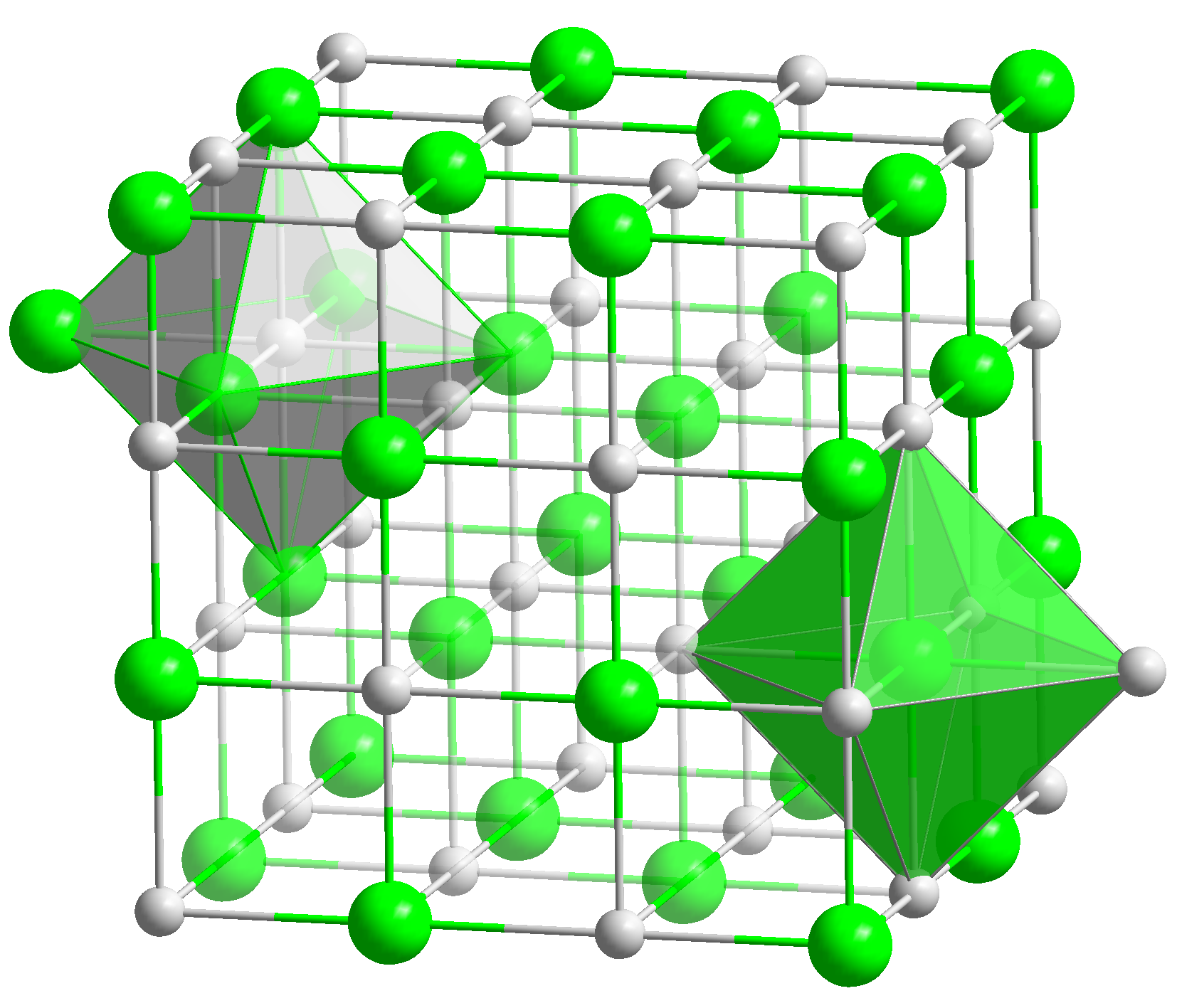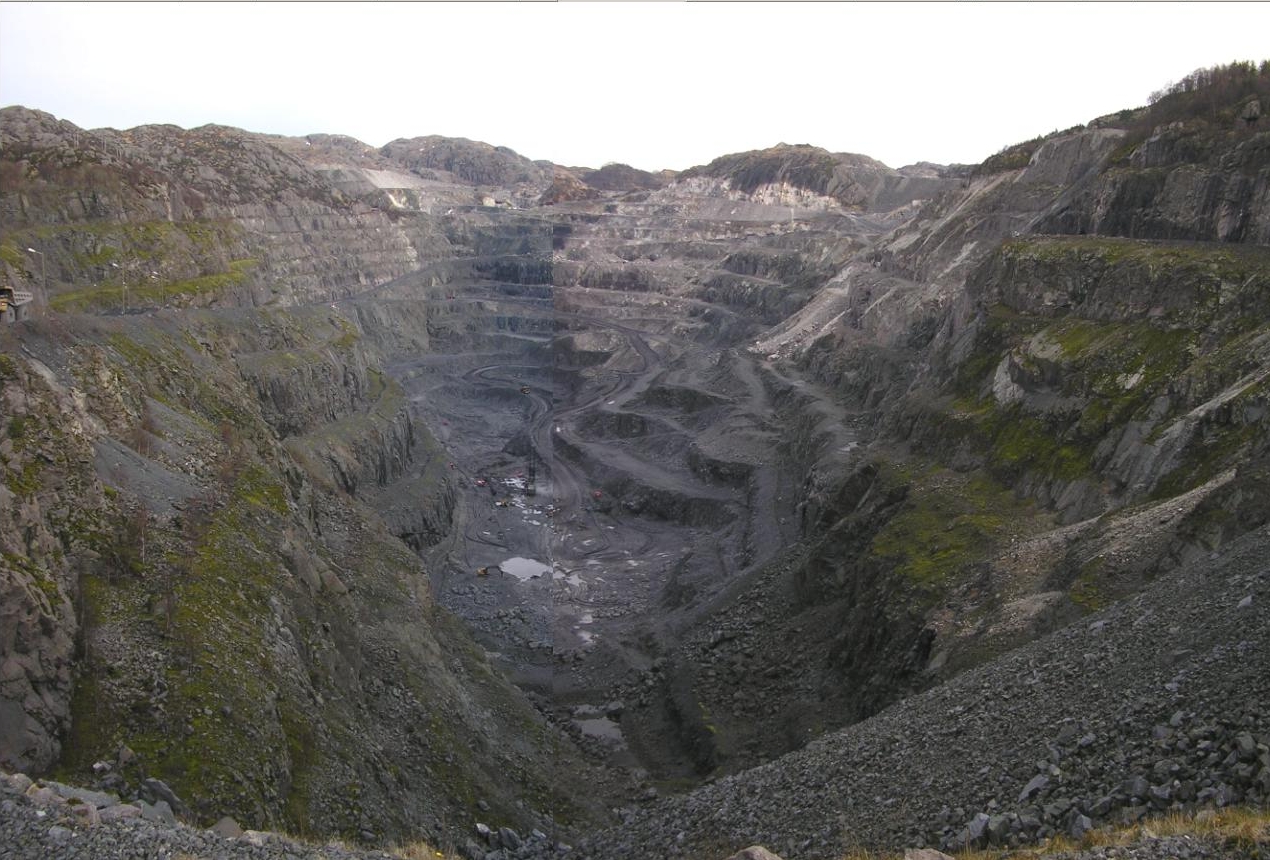|
Magnesiowüstite
Ferropericlase or magnesio wüstite is a magnesium/ iron oxide with the chemical formula that is interpreted to be one of the main constituents of the Earth's lower mantle together with the silicate perovskite (), a magnesium/iron silicate with a perovskite structure. Ferropericlase has been found as inclusions in a few natural diamonds. An unusually high iron content in one suite of diamonds has been associated with an origin from the lowermost mantle. Discrete ultralow-velocity zones in the deepest parts of the mantle, near the Earth's core, are thought to be blobs of ferropericlase, as seismic waves are significantly slowed as they pass through them, and ferropericlase is known to have this effect at the high pressures and temperatures found deep within the Earth's mantle. In May 2018, ferropericlase was shown to be anisotropic in specific ways in the high pressures of the lower mantle, and these anisotropies may help seismologists and geologists to confirm whether those ultra ... [...More Info...] [...Related Items...] OR: [Wikipedia] [Google] [Baidu] |
Wüstite
Wüstite ( Fe O) is a mineral form of iron(II) oxide found with meteorites and native iron. It has a grey colour with a greenish tint in reflected light. Wüstite crystallizes in the isometric-hexoctahedral crystal system in opaque to translucent metallic grains. It has a Mohs hardness of 5 to 5.5 and a specific gravity of 5.88. Wüstite is a typical example of a non-stoichiometric compound. Wüstite was named after Fritz Wüst (1860–1938), a German metallurgist and founding director of the ''Kaiser-Wilhelm-Institut für Eisenforschung'' (presently Max Planck Institute for Iron Research GmbH). In addition to its type locality in Germany, it has been reported from Disko Island, Greenland; the Jharia coalfield, Jharkhand, India; and as inclusions in diamonds in a number of kimberlite pipes. It also is reported from deep sea manganese nodules. Its presence indicates a highly reducing environment. Wüstite redox buffer Iron minerals on the earth's surface are typicall ... [...More Info...] [...Related Items...] OR: [Wikipedia] [Google] [Baidu] |
Synchrotron
A synchrotron is a particular type of cyclic particle accelerator, descended from the cyclotron, in which the accelerating particle beam travels around a fixed closed-loop path. The magnetic field which bends the particle beam into its closed path increases with time during the accelerating process, being ''synchronized'' to the increasing kinetic energy of the particles. The synchrotron is one of the first accelerator concepts to enable the construction of large-scale facilities, since bending, beam focusing and acceleration can be separated into different components. The most powerful modern particle accelerators use versions of the synchrotron design. The largest synchrotron-type accelerator, also the largest particle accelerator in the world, is the Large Hadron Collider (LHC) near Geneva, Switzerland, built in 2008 by the European Organization for Nuclear Research (CERN). It can accelerate beams of protons to an energy of 6.5 tera electronvolts (TeV or 1012 eV). ... [...More Info...] [...Related Items...] OR: [Wikipedia] [Google] [Baidu] |
Wollastonite
Wollastonite is a calcium inosilicate mineral ( Ca Si O3) that may contain small amounts of iron, magnesium, and manganese substituting for calcium. It is usually white. It forms when impure limestone or dolomite is subjected to high temperature and pressure, which sometimes occurs in the presence of silica-bearing fluids as in skarns or in contact with metamorphic rocks. Associated minerals include garnets, vesuvianite, diopside, tremolite, epidote, plagioclase feldspar, pyroxene and calcite. It is named after the English chemist and mineralogist William Hyde Wollaston (1766–1828). Despite its chemical similarity to the compositional spectrum of the pyroxene group of minerals—where magnesium (Mg) and iron (Fe) substitution for calcium ends with diopside and hedenbergite respectively—it is structurally very different, with a third tetrahedron in the linked chain (as opposed to two in the pyroxenes). Production trends Estimated world production of crude wollastonite ore ... [...More Info...] [...Related Items...] OR: [Wikipedia] [Google] [Baidu] |
Ilmenite
Ilmenite is a titanium-iron oxide mineral with the idealized formula . It is a weakly magnetic black or steel-gray solid. Ilmenite is the most important ore of titanium and the main source of titanium dioxide, which is used in paints, printing inks, fabrics, plastics, paper, sunscreen, food and cosmetics. Structure and properties Ilmenite is a heavy (specific gravity 4.7), moderately hard (Mohs hardness 5.6 to 6), opaque black mineral with a submetallic luster. It is almost always massive, with thick tabular crystals being quite rare. It shows no discernible cleavage, breaking instead with a conchoidal to uneven fracture. Ilmenite crystallizes in the trigonal system with space group ''R''. The ilmenite crystal structure consists of an ordered derivative of the corundum structure; in corundum all cations are identical but in ilmenite Fe2+ and Ti4+ ions occupy alternating layers perpendicular to the trigonal c axis. Pure ilmenite is paramagnetic (showing only very weak attra ... [...More Info...] [...Related Items...] OR: [Wikipedia] [Google] [Baidu] |
Post-perovskite
Post-perovskite (pPv) is a high-pressure phase of magnesium silicate (MgSiO3). It is composed of the prime oxide constituents of the Earth's rocky mantle (MgO and SiO2), and its pressure and temperature for stability imply that it is likely to occur in portions of the lowermost few hundred km of Earth's mantle. The post-perovskite phase has implications for the ''D''′′ layer, which influences the convective mixing in the mantle responsible for plate tectonics. Post-perovskite has the same crystal structure as the synthetic solid compound CaIrO3, and is often referred to as the "CaIrO3-type phase of MgSiO3" in the literature. The crystal system of post-perovskite is orthorhombic, its space group is ''Cmcm'', and its structure is a stacked SiO6-octahedral sheet along the ''b'' axis. The name "post-perovskite" derives from silicate perovskite, the stable phase of MgSiO3 throughout most of Earth's mantle, which has the perovskite structure. The prefix "post-" refers to the fact ... [...More Info...] [...Related Items...] OR: [Wikipedia] [Google] [Baidu] |
Ringwoodite
Ringwoodite is a high-pressure phase of Mg2SiO4 (magnesium silicate) formed at high temperatures and pressures of the Earth's mantle between depth. It may also contain iron and hydrogen. It is polymorphous with the olivine phase forsterite (a magnesium iron silicate). Ringwoodite is notable for being able to contain hydroxide ions (oxygen and hydrogen atoms bound together) within its structure. In this case two hydroxide ions usually take the place of a magnesium ion and two oxide ions. Combined with evidence of its occurrence deep in the Earth's mantle, this suggests that there is from one to three times the world ocean's equivalent of water in the mantle transition zone from 410 to 660 km deep. This mineral was first identified in the Tenham meteorite in 1969, and is inferred to be present in large quantities in the Earth's mantle. Ringwoodite was named after the Australian earth scientist Ted Ringwood (1930–1993), who studied polymorphic phase transitions i ... [...More Info...] [...Related Items...] OR: [Wikipedia] [Google] [Baidu] |
Transition Zone (Earth)
The transition zone is part of the Earth's mantle, and is located between the lower mantle and the upper mantle, between a depth of 410 and 660 km (250 to 400 mi). The Earth's mantle, including the transition zone, consists primarily of peridotite, an ultramafic igneous rock. The mantle was divided into the upper mantle, transition zone, and lower mantle as a result of sudden seismic-velocity discontinuities at depths of 410 and 660 km (250 to 400 mi). This is thought to occur as a result of rearrangement of grains in olivine (which constitutes a large portion of peridotite) at a depth of 410 km, to form a denser crystal structure as a result of the increase in pressure with increasing depth. Below a depth of 660 km, evidence suggests due to pressure changes ringwoodite minerals change into two new denser phases, bridgmanite and periclase. This can be seen using body waves from earthquakes, which are converted, reflected or refracted at the bound ... [...More Info...] [...Related Items...] OR: [Wikipedia] [Google] [Baidu] |
Perovskite
Perovskite (pronunciation: ) is a calcium titanium oxide mineral composed of calcium titanate (chemical formula ). Its name is also applied to the class of compounds which have the same type of crystal structure In crystallography, crystal structure is a description of the ordered arrangement of atoms, ions or molecules in a crystalline material. Ordered structures occur from the intrinsic nature of the constituent particles to form symmetric patterns t ... as (XIIA2+VIB4+X2−3), known as the perovskite (structure), perovskite structure. Many different cations can be embedded in this structure, allowing the development of diverse engineered materials. History The mineral was discovered in the Ural Mountains of Russia by Gustav Rose in 1839 and is named after Russian mineralogist Lev Perovski (1792–1856). Perovskite's notable crystal structure was first described by Victor Goldschmidt in 1926 in his work on tolerance factors. The crystal structure was later published ... [...More Info...] [...Related Items...] OR: [Wikipedia] [Google] [Baidu] |
Density
Density (volumetric mass density or specific mass) is the substance's mass per unit of volume. The symbol most often used for density is ''ρ'' (the lower case Greek letter rho), although the Latin letter ''D'' can also be used. Mathematically, density is defined as mass divided by volume: : \rho = \frac where ''ρ'' is the density, ''m'' is the mass, and ''V'' is the volume. In some cases (for instance, in the United States oil and gas industry), density is loosely defined as its weight per unit volume, although this is scientifically inaccurate – this quantity is more specifically called specific weight. For a pure substance the density has the same numerical value as its mass concentration. Different materials usually have different densities, and density may be relevant to buoyancy, purity and packaging. Osmium and iridium are the densest known elements at standard conditions for temperature and pressure. To simplify comparisons of density across different syst ... [...More Info...] [...Related Items...] OR: [Wikipedia] [Google] [Baidu] |
Electron Magnetic Moment
In atomic physics, the electron magnetic moment, or more specifically the electron magnetic dipole moment, is the magnetic moment of an electron resulting from its intrinsic properties of spin and electric charge. The value of the electron magnetic moment is The electron magnetic moment has been measured to an accuracy of relative to the Bohr magneton. Magnetic moment of an electron The electron is a charged particle with charge −, where is the unit of elementary charge. Its angular momentum comes from two types of rotation: spin and orbital motion. From classical electrodynamics, a rotating distribution of electric charge produces a magnetic dipole, so that it behaves like a tiny bar magnet. One consequence is that an external magnetic field exerts a torque on the electron magnetic moment that depends on the orientation of this dipole with respect to the field. If the electron is visualized as a classical rigid body in which the mass and charge have identical distribut ... [...More Info...] [...Related Items...] OR: [Wikipedia] [Google] [Baidu] |
X-ray Spectroscopy
X-ray spectroscopy is a general term for several spectroscopic techniques for characterization of materials by using x-ray radiation. Characteristic X-ray spectroscopy When an electron from the inner shell of an atom is excited by the energy of a photon, it moves to a higher energy level. When it returns to the low energy level, the energy which it previously gained by the excitation is emitted as a photon which has a wavelength that is characteristic for the element (there could be several characteristic wavelengths per element). Analysis of the X-ray emission spectrum produces qualitative results about the elemental composition of the specimen. Comparison of the specimen's spectrum with the spectra of samples of known composition produces quantitative results (after some mathematical corrections for absorption, fluorescence and atomic number). Atoms can be excited by a high-energy beam of charged particles such as electrons (in an electron microscope for example), protons (se ... [...More Info...] [...Related Items...] OR: [Wikipedia] [Google] [Baidu] |



_crystallographic_standard_alignment.png)
